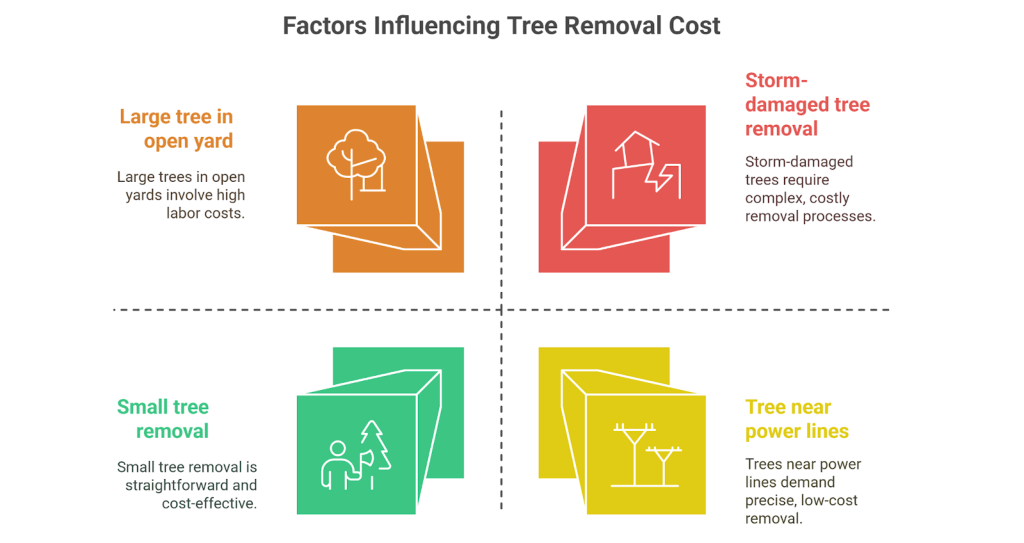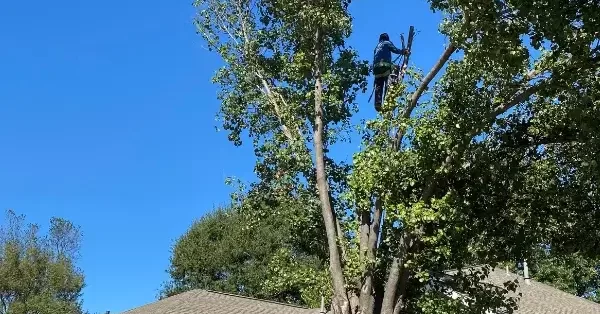We hear this one a lot from homeowners across North Texas-whether you’re in Frisco, Arlington, or over in McKinney: “What’s it cost to take out a tree?” The honest answer? It depends. Every tree, every yard, and every setup is different.
Over the years, we’ve handled removals in all kinds of situations-tight lots with HOAs, big open yards out in the suburbs, you name it. Here’s what we usually explain before giving anyone a price.
What Really Affects Tree Removal Costs
When you’re trying to figure out what you’ll pay to remove a tree, a few things usually play the biggest role:
- Tree size and type: Larger trees or those with thick, dense branches simply take longer to cut down and clean up.
- Where the tree is: If your tree is squeezed between houses, close to fences, or near power lines, it takes more time and care to remove safely.
- Condition of the tree: A dead, rotting, or storm-damaged tree can be unpredictable, so crews often need extra safety steps and more time to get it down.
- Access for equipment: If there’s no way to get machinery to the tree, the team may have to climb and cut it by hand. This adds time, labor, and risk.
- Clean-up level: Some people just want the tree down and left on the ground. Others want all debris cleared, logs hauled away, and the stump removed too. Each of these choices adds to the final price.
Basically, the more challenging the job, the more people, planning, and tools it takes — which means a higher cost.

Is Tree Removal Covered by Insurance?
Sometimes yes, sometimes no. If a storm blew the tree over and it’s leaning on your fence or roof, your insurance might step in. But if it’s a healthy tree you’re removing for aesthetic reasons, it’s probably not covered. It’s a good idea to call your insurance company first. They may ask for pictures or a written note from an arborist before they’ll make a call.
Do You Need a Permit in the DFW Area?
Some cities here in the Metroplex do require a permit, especially if the tree is over a certain size or species. Dallas, Plano, and Arlington all have different rules, and some neighborhoods with HOAs do too. Always check in with your city office or community guidelines before removing anything. We’ve seen folks get hit with fines because they didn’t realize what counted as a “protected” tree. Check our guide on whether you need a permit to remove a tree.
What to Ask Before Hiring
Before you sign anything, we always recommend asking:
- Are you fully insured and bonded?
- Does the quote include stump grinding and cleanup?
- How do you plan to protect the yard, driveway, and nearby structures?
- Do you have references from other jobs in this area?
A good crew will have no problem answering all of that-and if they hesitate, that’s a red flag.
Common Mistakes to Avoid During Tree Removal
We’ve been called to clean up after jobs that didn’t go right. Here are the most common mistakes:
- Skipping the permit check or HOA approval.
- Forgetting to call 811 before digging or grinding-roots can run right over utilities.
- Picking the cheapest bid without asking what’s actually included.
- Not confirming if stump work or haul-away is part of the deal.
It’s better to slow down and get the details right than deal with a mess after the fact.
Alternatives to Full Tree Removal
Sometimes, you’ve got options besides cutting the whole tree. If it’s healthy and just in the way or leaning, here’s what we might suggest instead:
| Problem |
What to Consider |
| Hanging limbs or deadwood |
Pruning or limb removal |
| Tree leaning slightly |
Bracing or cabling support |
| Blocking sunlight |
Canopy lift or thinning |
| Too many trees in one space |
Selective thinning |
| Roots near a structure |
Root pruning or barriers |
We’d always rather help you save a healthy tree if it’s possible and safe.
Cost-Related Questions Homeowners Ask Us All the Time
How much does tree removal usually cost?
It depends on the size of the tree, where it’s located, and how easy it is to access. Small trees can be a few hundred dollars. Large or risky removals can run into the thousands. Always ask for a clear estimate before work starts.
What makes tree removal more expensive?
Trees that are bigger, near power lines, close to your house, or hard to reach usually cost more to remove. Needing extra equipment or a bigger crew adds to the final price.
Is stump removal included in the cost?
Not always. Stump grinding is often a separate line item. Some people leave the stump to save money upfront, but keep in mind removing it later can be more expensive.
Does insurance cover tree removal?
Sometimes. If a tree falls due to a storm and damages your home, insurance may pay for removal. But if you’re removing a healthy tree for safety or cosmetic reasons, you’ll likely pay out of pocket.
Do I pay upfront or after the job is done?
Reputable companies don’t expect full payment until the work is finished and you’re happy with it. A small deposit may be normal, but be cautious about paying in full beforehand.
Planning Tree Work Around Seasonal Conditions in DFW
We work year-round, but the weather plays a part in timing:
- Spring: High winds and soft ground can delay bigger removals.
- Summer: Drought stress shows up, and we work early to avoid the heat.
- Fall: Great time for big jobs-dry weather, cooler temps.
- Winter: Perfect for dormant pruning and removals when trees are less active.
Planning your timing around DFW seasons helps everything go smoother.
Final Word from the Field
Tree removal isn’t something you want to rush through. Whether it’s storm cleanup in Arlington or a yard makeover in Frisco, it pays to slow down and do it right.
Still figuring things out? Give us a call at Quality Tree Service DFW. We’ll take a look, walk the yard with you, and give you real answers. No pressure-just solid help from folks who know this work and this area.








